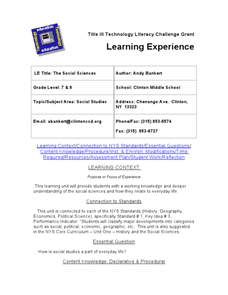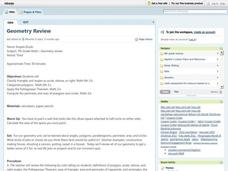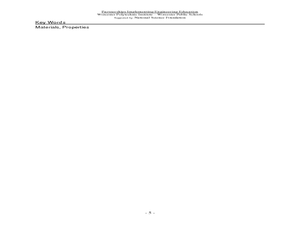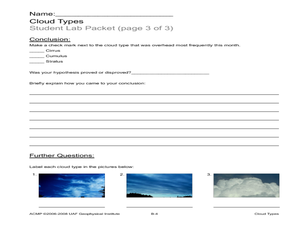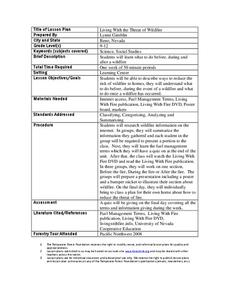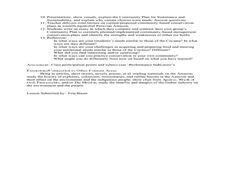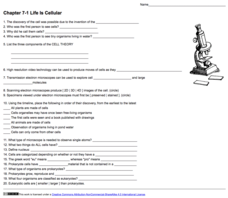Curated OER
The Battle of Stones River: The Soldiers' Story
Learners organize items in a "doohickey kit" distributed by the teachers, creating categories using classification schemes. In this classification lesson, students compare systems within groups and write questions that could be answered...
Curated OER
The Bell Curve
Students explore the concept of the bell curve. In this bell curve lesson plan, students discuss the controversy associated with the bell curve. Students use an applet to explore a normal distribution. Students discuss mean, median,...
Curated OER
Water and Ice
Students investigate the states of matter. In this physics lesson plan, students use water and ice to demonstrate the characteristics of a solid and liquid. Students record their observations as the state of the water changes.
Curated OER
School Site Ecosystem
Fourth graders are introduced to the concept of ecosystem; specifically, the interrelationships among plants and animals within an ecosystem, and their relationships to the environment in which they live and interact.
Curated OER
The Right Chemistry
Students see that chemistry is the study of matter, how matter reacts and combines to create new chemicals, the changes that take place in matter and what makes up matter. This lesson provides many good ideas across the curriculum to...
Curated OER
Needs and Wants
Students examine the difference between psychological needs and wants to control spending.
Curated OER
The Social Sciences
Students search for examples of social science in and around their school. They create a Social Science scrapbook of the eight social sciences, that includes news articles and summaries that focus on each social science area.
Curated OER
Discovering the Problem of Solid Waste
Students catagorize the types of garbage from going through a trash can provided by their teacher. They then chart the items on a graph and propose a solution to reduce the amount of garbage.
Curated OER
Huey and Louie Meet Dewey
Students exercise their library shelving skills. Students complete a worksheet that aids a rambunctious student who needs their help. Students become familiar with the Dewey decimal classification system. Students organize books on the...
Curated OER
Teaching Imagery with Gary Paulsen
Middle schoolers read excerpts from memoirs written by Gary Paulsen as examples of how to write a narrative piece. They identify figurative language used and then they write a memoir of their own that contains imagery and figurative...
Curated OER
Why Do We Have Thanksgiving?
Students investigate the change in the Thanksgiving holiday over time. They research the Native Americans and Pilgrims to find out how their relationship affected the holiday. They create a PowerPoint presentation using digital cameras...
Curated OER
Geometry Review
Seventh graders explore basic geometric definitions involving angles, area, and circumference. To reinforce basic geometric concepts, they play a "lightning Flash" card game. Students discuss chores or jobs that require the use of...
Curated OER
How Do People Get Energy?
In this food energy worksheet, students will write in examples of different foods that fit into the four food groups: grains, protein, fruits and vegetables, and milk products.
Curated OER
Heredity
For this heredity worksheet, learners review how genes are involved in the inheritance of certain traits through generations. Students complete a Punnett square and review probability. This worksheet has 11 short answer and 11 fill in...
Alabama Learning Exchange
Three in a Row Calendar Game
Students explore a calendar. In this calendar and math instructional activity, students view a video clip about using a calendar. Students participate in a game in which a game board is used to identify days of the week, dates, and months.
Curated OER
Critters in Your Own Backyard
Students identify various animals and their habitats, as well as their specific traits In this animal habitat lesson, students list animals they've seen in their backyard. Students select one animal and do research. Students then answer...
Curated OER
Introduction to Materials: Properties of Materials
Students explore the properties of matter. In this properties of materials lesson, students examine wood, metal, rubber, Styrofoam, and plastic. Students identify the attributes of each of the materials.
Curated OER
Cloud Types
Students examine cloud types. In this cloud lesson plan, students identify cloud types, observe clouds and collect data, and analyze data to identify the most common cloud they observe overhead during the course of a month.
Curated OER
Living with the Threat of Wildfire
Learners describe the risk of wildfires. In this fire safety lesson, students describe ways to reduce the risk of wildfires to residential areas. They study what to do before, during and after the occurrence of a wildfire. Learners...
Curated OER
Basic Knowledge of Big Cats
First graders create a KWL chart on big cats. In this animal science lesson, 1st graders brainstorm what they already know about big cats and research big cats using various suggested websites. Students fill in the last column of the KWL...
Curated OER
Supermarkets, Sustenance and Sustainability
Students investigate jungles and the people who depend upon them. In this sustainability lesson, students research wild life conservation and discover the importance of a jungle to Amazonian people. Students create a group...
Biology Corner
Life is Cellular
For this cells activity, students answer questions about the first person to see a cell as well as the evolution of microscopes. They define the parts of a cell and tell the differences between Prokaryotes and Eukaryotes. There are 20...
Curated OER
Characteristics of Reptiles Lesson Plan
First graders draw pictures of reptiles and share them with the class describing the characteristics of the reptile. In this reptiles lesson plan, 1st graders determine if animals in pictures are reptiles or not.
Curated OER
Let's Clean the Beach!
Students volunteer their time to clean a local park. They estimate the amount of debris they collect and make observations. They write a poem and draw an illustration about their experience.








